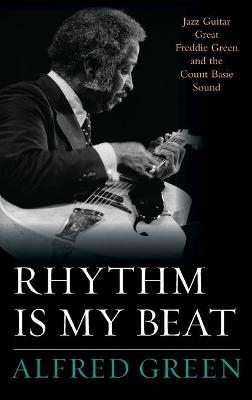
Rhythm Is My Beat
Rowman & Littlefield (Verlag)
978-1-4422-4246-3 (ISBN)
This American jazz icon, much like his inimitable sound, achieved stardom as a sideman, both in and out of Basie’s band. Green’s signature sound provided lift to soloists like Lester Young and vocalist Lil’ Jimmy Rushing, a reflection of Green’s sophisticated technique, that produced, in Green’s words, his “rhythm wave.” Billie Holiday, Ruby Braff, Benny Goodman, Gerry Mulligan, Teddy Wilson, Ray Charles, Judy Carmichael, Joe Williams and other recording artists all benefited from the relentless fours of the man who came to be known as Mr. Rhythm. The mystique surrounding Freddie Green’s technique is illuminated through generous commentary by insightful interviews with other musicians, guitar professionals and scholars, all of whom offer their ideas on Freddie Green’s sound. Alfred Green throughout demystifies the man behind the legend.
This work will interest jazz fans, students, and scholars; guitar enthusiasts and professionals; music historians and anyone interested not only in the history of jazz but of the African American experience in jazz.
Alfred Green received his masters in social work from the University of Southern California. In 1984 he served as vice president of production at Academic Press Inc. in San Diego. Green was a freelance photographer for ten years and a member of the American Society of Magazine Photographers (ASMP) with assignments for Fortune, New York, Scholastic, Financial World and Black Enterprise Magazine. He covered the 12th OAU Conference in Kampala, Uganda, with additional assignments in Angola, Puerto Rico and Spain. He retired from the Los Angeles Unified School District as a psychiatric social worker. He currently lives on the west coast with his wife, Judy.
Dedication
Foreword
Preface
Acknowledgment
Chronology
Chapter 1: God Said: “Let There Be Rhythm” and Freddie Green Heard the Call
Chapter 2: The Trail to Basie
Chapter 3: Finding the Groove
Chapter 4: Building the Wave
Chapter 5: On the Road
Chapter 6: You Don’t Screw With What Got You Here
Chapter 7: “You Don’t Have to Shout to Be Heard.”
Chapter 8: Mr. Rhythm the Man
Appendix 1: The Quest of Freddie Green: From Ukulele to “Mr. Rhythm” by Michael Pettersen
Appendix 2: The Dynamic Chord and Muted Notes (DCMN) analysis of Freddie Green's Rhythm Guitar Style: What's in a "One-Note" Chord? by M.D. Allen
Appendix 3: For the Experienced Jazz Guitarist: Freddie Green Fundamentals by Michael Pettersen
Appendix 4: Favorite Chord Voicings of Freddie Green by Michael Pettersen
Appendix 5The String Height of Freddie's Guitar and How It Shaped His Unique Style by Michael Pettersen
Appendix 6: Did Freddie Green always play the guitar chart “as written?” by Michael Pettersen
Appendix 7: Improvised Jazz Counterpoint: The Stylistic Characteristics of Freddie Green’s Rhythm Guitar Playing by Trevor de Clerq
Appendix 8: Freddie Green's One Note Chord Technique: Supporting Evidence from Other Guitarists
Appendix 9: Chapter Transcriptions
Appendix 10: The Ultimate Transcription
Appendix 11: Freddie Green Compositions, compiled by Mark Allen
Appendix 12: Freddie Green Recordings: A Selected Discography
Appendix 13: Freddie Green on Film and Video
Appendix 14: Freddie Green's Non-Basie Recordings
Bibliography
| Reihe/Serie | Studies in Jazz |
|---|---|
| Verlagsort | Lanham, MD |
| Sprache | englisch |
| Maße | 161 x 235 mm |
| Gewicht | 680 g |
| Themenwelt | Literatur ► Biografien / Erfahrungsberichte |
| Kunst / Musik / Theater ► Musik ► Jazz / Blues | |
| ISBN-10 | 1-4422-4246-9 / 1442242469 |
| ISBN-13 | 978-1-4422-4246-3 / 9781442242463 |
| Zustand | Neuware |
| Haben Sie eine Frage zum Produkt? |
aus dem Bereich


